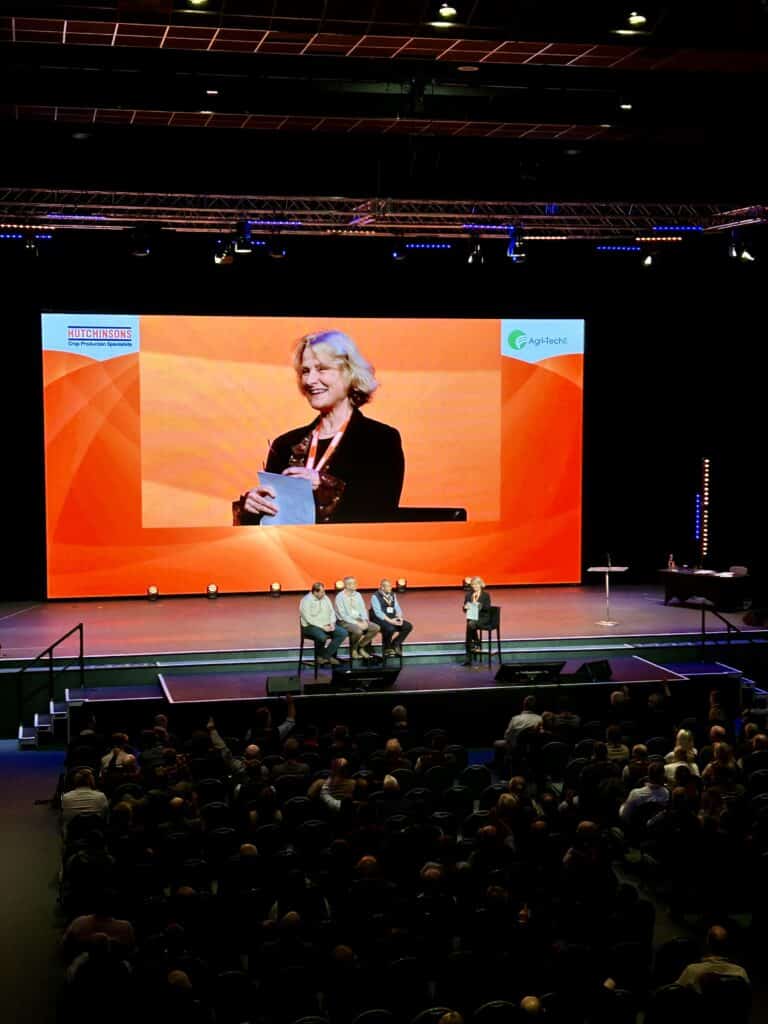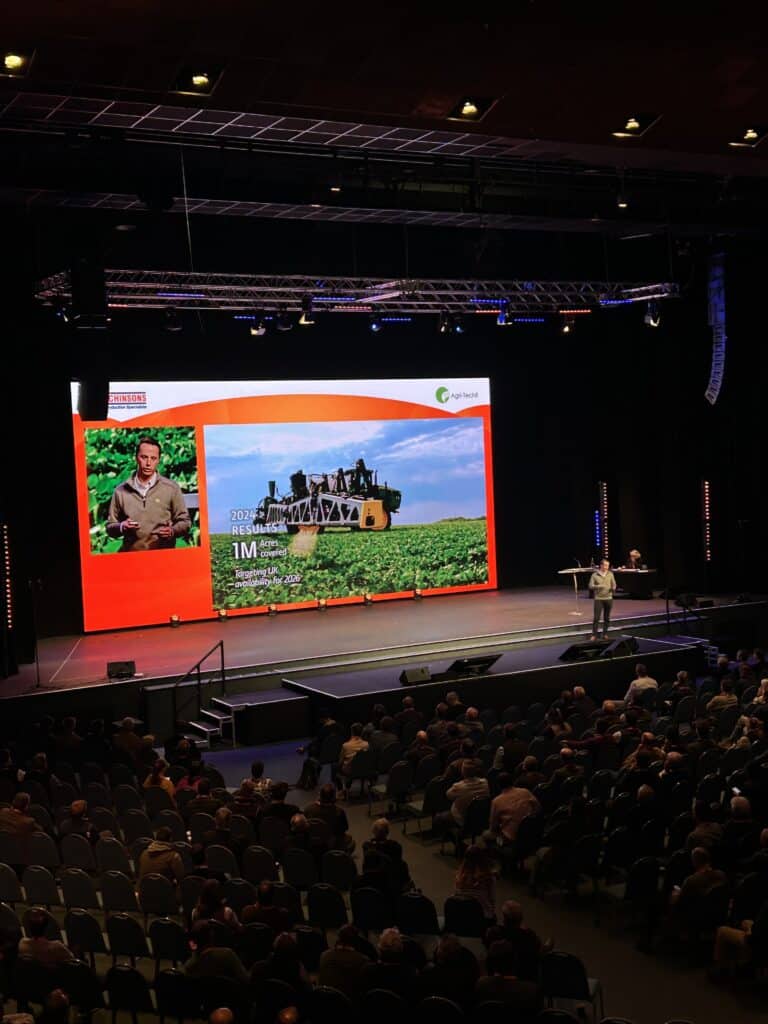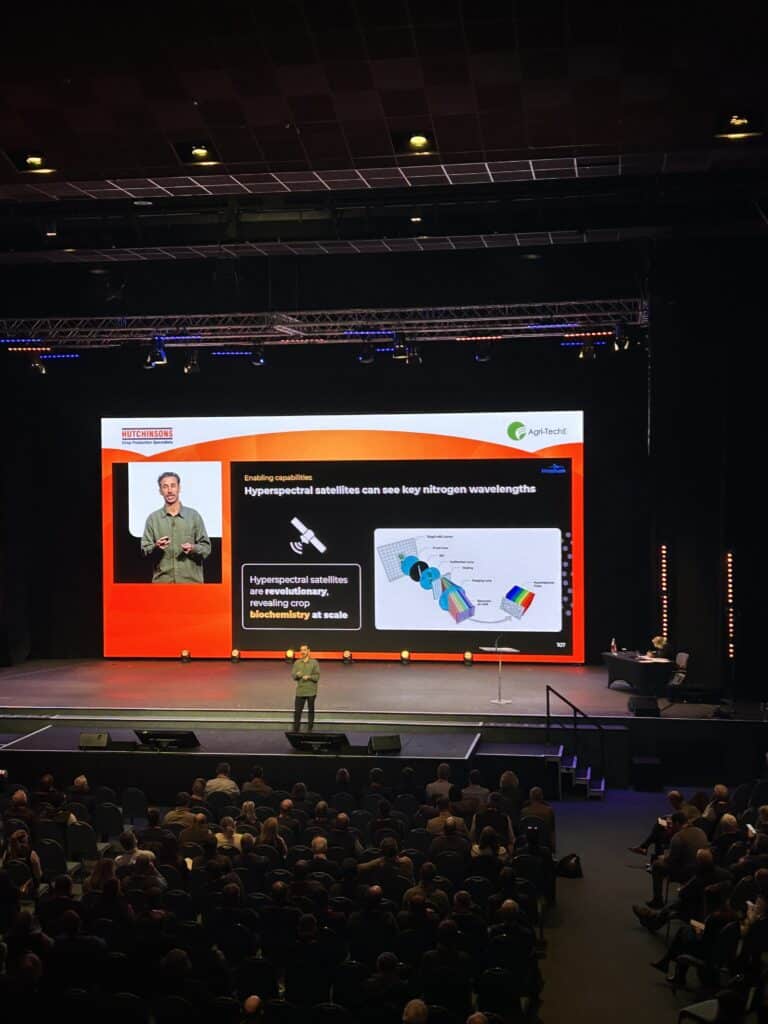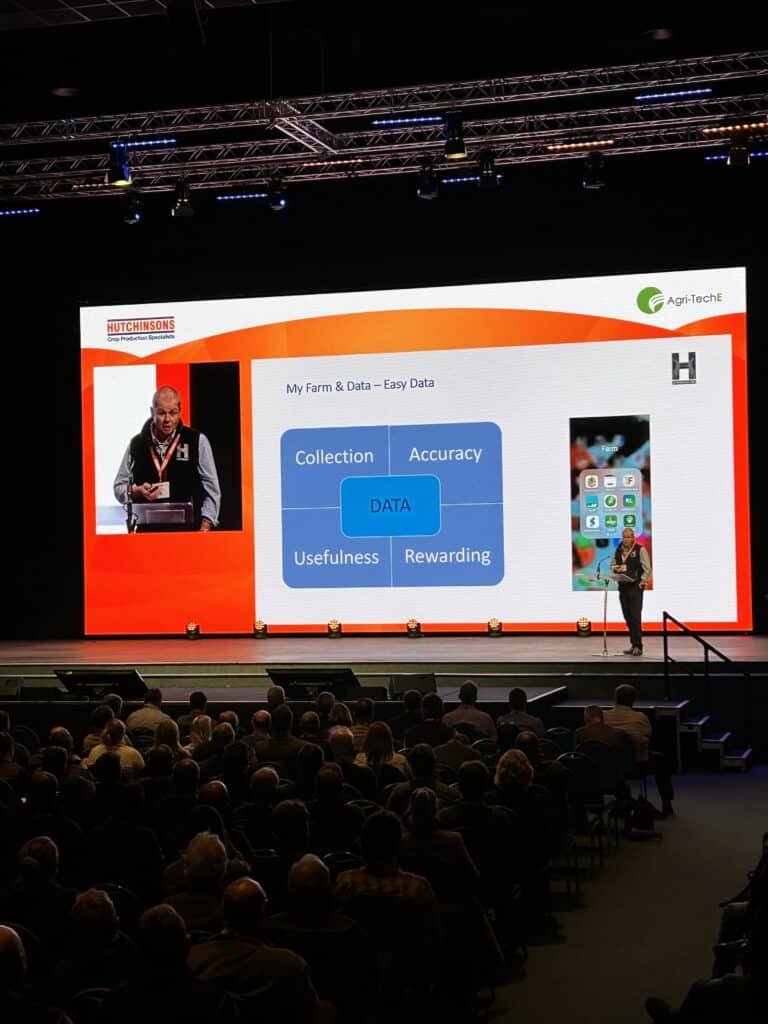Conference focuses on data-driven technology for farm profitability – Farmers Guide
The recent Hutchinsons and AgriTech-E Connected Farming Technology conference proved a success ...
Over 500 attendees ranging from growers and agronomists to industry representatives and technical experts came together at the Hutchinsons and AgriTech-E Connected Farming Technology Conference in December to discuss how data driven technology can be used to improve the profitability of UK arable farms.
Andrew McShane, Hutchinsons chairman, opened proceedings outlining how the premise of the conference was to hear about how technologies driven by data, those already available as well as future technologies, can help farms be more productive, whilst also providing a platform to those already trying these technologies to share their learnings.
Dennis Schrijver, John Deere precision agriculture specialist, who took to the stage told the audience that he believes data connectivity has potential to unlock “billions in value” for the global agriculture industry over the next five years.
“There are already many ways technology and data can drive efficiency, profitability and sustainability, but systems must be able to ‘talk’ to each other. We have seen in the UK and elsewhere that connectivity can be a challenge, but our aim is to make sure we have connectivity with our machines to help farmers manage their farms more efficiently.”
Key developments
Mr Schrijver highlighted a number of key developments within the firm’s range of technology and data systems that he said would help farmers improve productivity, profitability and sustainability.
Guidance
Almost 24 years on from the launch of AutoTrac guidance, innovations such as the AutoPath boundary feature allow automatic calculation of guidance lines for the whole field, including headlands, saving time, reducing operator stress, and improving field efficiency. Turn Automation also offers automatic management of tractor and implement, or combine functions, facilitating faster, safer, more efficient turns.
Data sharing
JD’s cloud-based Operations Centre is the main hub for its data collection and secure storage, allowing complete integration across production systems, machine monitoring, remote access, and full compatibility with other platforms, such as Omnia, meaning farmers can seamlessly transfer data between the two.
In the field, data such as coverage maps can be shared between machines working in the same field to increase productivity and save time, while the wireless Machine Sync function allows operators to manage the speed, direction and position of multiple machines in the same field (e.g. for harvesting potatoes, vegetables and forage).
See & Spray
John Deere’s ‘See & Spray’ system uses cameras on the sprayer boom and machine learning to target herbicide applications to individual weeds, potentially cutting herbicide use by 60%. The system has been developed in the US for use in corn, soybean, and cotton, but will be able available to UK growers in 2026.
Harvest automation
Analysis of data from JD combines in the field shows many are not operated at maximum capacity, so a harvest automation system has been developed to automatically control settings such as forward speed to ensure machines run at maximum output. This could deliver a 20% productivity gain, Mr Schrijver said.
Fully autonomous system
With fully autonomous tractors already developed, Mr Schrijver said the firm’s aim ‘was to offer a completely autonomous production system, from tillage to harvest, by 2030. Messium CEO George Marangos- Gilks, took to the stage to talk about an innovative system that uses cutting-edge satellite imaging to precisely measure crop nitrogen which could be a game-changer for fertiliser planning on farms after promising results in 2024 trials.
The Messium nitrogen estimator uses a network of hyperspectral satellites to measure the nitrogen concentration within plants at a high spatial resolution, before sophisticated computer modelling and Al generates accurate nitrogen recommendations for growers. This modelling takes into account factors such as nitrogen response curves, crop requirements at different growth stages, and the weather.
Unlike other satellite systems that focus on crop biomass (NDVI), measuring nitrogen concentration is a far more effective way of preventing under- or over-fertilising crops.
Indeed, as part of 2024 trials, 1,000 physical crop samples from 47 farms across Europe, were tested for nitrogen and biomass, revealing half of fields were over fertilised by an average of 40%, and 39% were under-fertilised by an average of 28%.
“Globally, we’ve collected over 13,000 samples for lab analysis of biomass and nitrogen concentration. Each sample has a unique GPS pin, which allows the data to be matched to the satellite image. The more times we do that, the more accurate and powerful our Al model becomes,” said Mr Marangos-Gilks.
“In the future, we want to be able to give N recommendations without the need for sampling.”
Hyperspectral satellites offered greater accuracy than tractor-mounted sensors and were more cost-effective than drone-based imaging over large areas, he added. Also, with a network of 15 hyperspectral satellites due to be operational in 2025, he said there was a greater chance of capturing a successful image on clear days than with most NDVI imaging, which typically used 2-4 satellites.
On-farm benefits
Last season, Messium conducted trials on 14 UK farms, with a clear benefit seen on 10 of those.
One farm that took part was the Helix East Anglia demonstration in Suffolk, hosted by Tom Jewers, where nitrogen response trials saw eight different rates examined, ranging from 0-250kg N/ha. “Sampling of the Messium strip found it had luxury nitrogen, so we asked Tom to apply nitrogen to that strip 12 days later than the rest of the field,” Mr Marangos-Gilks explained. “This reduced the luxury nitrogen, so the crop was far more able to take up subsequent nitrogen applied.”
That was reflected in final yields. The Messium strip, which received 227kg N/ha in total, yielded 11.88t/ha, 0.5t/ha more than the next-best, which did 11.3t/ha from 225kg N/ha. The farm standard plot of 200kg N/ha came in at 11t/ha.
Mr Jewers was impressed with the result, although recognised it was only one year’s data. If similar results were to be repeated in future seasons, it could be a game-changer for fertiliser recommendations, he said.
Farmers wanted
Messium wants to expand its farm trials next season, so is looking for farmers willing to vary nitrogen rates in the most over- and under- fertilised areas of fields at different times through the season, and collect yield data.
Messium will provide:
- Nitrogen heat maps of the farm to help pinpoint areas with the greatest over-and under-fertilisation
- Independent sampling of 30-50 samples, three or four times through the season to ensure imaging data and model recommendations are accurate
- Timing and quantity recommendations for growers
- An end of season assessment of benefits for the entire farm.
“We’re asking farmers to make a small contribution towards the costs of running the trial, typically £300-600,” Mr Marangos-Gilks said. “In return, we’re offering a £1,000 discount on using Messium in the future and also guarantee the Messium strip will deliver a 7% net improvement compared with the adjacent strip. If we don’t achieve that, we’ll refund the money.”
Value from data on Lincs farm
South Lincolnshire farmer David Hoyles of G H Hoyles, is using a wide range of technology and data recording to improve efficiency across the 700ha of mixed cropping that includes cereals, veg and roots.
Speaking at the conference Mr Hoyles outlined how digital mapping systems including Omnia and Terramap, yield mapping, telematics, and irrigation scheduling systems, all now help with day-to-day management and legislation compliance, however he acknowledges it is an ongoing learning curve.
“We’ve been collecting data for quite a few years, but haven’t always been very accurate at it. We started in 2007, using autosteer guidance to save fuel and make operator life a bit easier. Then, in 2010, we set up a MyJohnDeere account, which was our first introduction to data collection and data use.”
Mr Hoyles admits data collection and inputting was quite “scruffy” in those early years, limiting its accuracy, but processes have improved as knowledge and the technology has developed.
“In the early days, for example, we might call a field ‘Field 1’ on one system, but on another it might be ‘Field 01; but the computer didn’t recognise them as being the same. Things are significantly better now, which makes the data much more useful, although we still don’t always get it right.”
Recently, the focus has been on tidying up parameters such as field boundaries, AB lines, latitude and longitude GPS coordinates, to make data as accurate as possible and allow “smarter” machinery placement across every field.
“We’ve done a lot with gathering and tidying data collection, which has made a real difference to the way we run the business. However, we still need to get better at getting value out of the data to give us a return on investment.”
Below are some examples of where Mr Hoyles is currently using data and technology to improve performance across the farm:
Telematics:
Alongside existing John Deere systems, in 2020 the farm started using Bayer’s FieldView, originally as a telematics “bolt-on” for an older combine. This provides real-time yield data to help plan storage requirements, crop quality information, and field movement logistics. FieldView is also used to efficiently map and record yields from in-house replicated agronomy trials, rather than having to combine plots and put loads over a weighbridge separately.
Irrigation planning & water management:
FieldView’s water use efficiency programme provides a more cost-effective, broad-acre way of estimating daily crop water demands than expensive soil moisture probes, although these are still used in some areas.
Data recording systems are used for legislation compliance (namely the Reservoir Act), recording water abstraction, application, etc. Electronically controlled conductivity meters are used to ensure only water of the right quality is abstracted for the farm’s own use and for sale to neighbours.
Digital mapping:
The farm started using Omnia in 2015, initially to help prepare variable rate seed rate plans. The system is now widely adopted for collating a host of management information, used for both variable seed and nutrition planning, cultivation planning, and general management, record-keeping, compliance and budgeting. Having remote access to data is particularly useful.
Some of the farm has been Terramapped to provide detailed soil information – mapping also proved useful for irrigation hydrant planning.
Omnia cost of production mapping, together with yield and soil maps, has been used to identify consistently poor performing areas, that may be better put to other uses, including stewardship, SFI, and even a dog park diversification, which now returns the equivalent of £8,000/ha.
Renewables:
The farm has 300kW of solar and a 100KW wind turbine, so recording data from these helps demonstrate reductions in electric and fuel use across the farm, which has reduced the carbon footprint over the past decade. Mr Hoyles is considering installing battery storage that can be charged during the day and used to supply electricity to the farm’s cold stores during peak-rate times.
Solar output data, particularly in early summer, shows a close correlation with crop yields, which can help budgeting. E.g. in 2024, solar output was 20% down year-on-year, similar to the drop in crop yields.
“The more data we collect, the more we’ll learn, allowing us to adapt in following years,” concludes Mr Hoyles.



